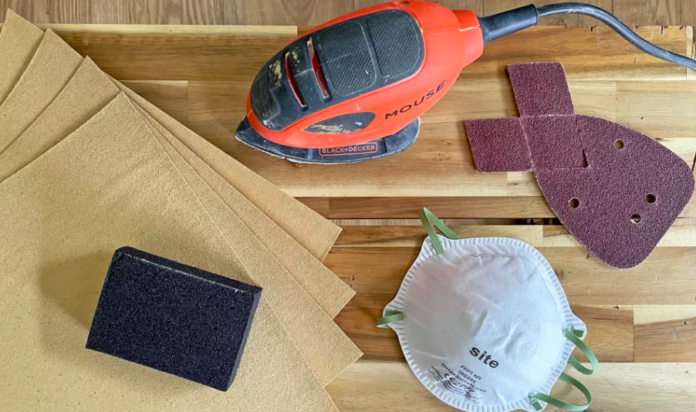Sanding is the most important step if you want to turn a piece of raw wood into something that adds value to your home or if you want to get rid of peeling paint or rust on metal furniture so that it regains its smooth surface.
Sanding does not necessarily transform a piece of material, including wood, glass, or metal, in the same way as cutting does. However, it is an important finishing or polishing process since it eliminates surface flaws in such materials.
What Is Sanding?
Sanding is a useful technique for achieving a smooth finish. It provides a uniform and smooth surface on the workpiece by using coated abrasives. This procedure is essential not just for removing surface flaws but also for getting the material ready for the application of finishes and coatings in the next phase of the working process.
Although sanding seems to smoothen the surface of your material, it actually coarsens rough surfaces such as wood fibers. Sandpaper and sanders are used with their abrasive function as a cutting tool to cut, shape, and polish unfinished material until it is ready for finishing.
Sanding Methods and Procedures
- Sanding By Hand
Hand sanding is a process that must be completed before a piece of material, such as furniture, can be painted. When sanding by hand, you have more control over the final form of the object. You have access to hard-to-reach areas that a machine would be unable to access. This is done to guarantee that all of the lines and curves of the object are polished to a smooth finish.
You can either buy or make a sanding block to smooth out flat areas and sharp corners. The sanding block is meant to keep the same amount of pressure on the sandpaper without making it bunch up or slip.
Sanding curves and rounded edges requires gentle pressure and a light touch. Apply even pressure and sand with the grain, not against it. Instead of using pencil marks or dried glue to fix nail holes, use sandpaper to smooth the joints.
Also, you can use a rubber or foam profile sander to smooth out intricate molding and trim.
Learn how to sand by hand using special tools and good-quality sandpaper to get better results with less work.
- Sanding with Power Tools
Electric or battery-powered sanders can quickly abrade surfaces for home repair and renovation activities. A power sander can be used to remove paint or varnish, refinish hardwood floors, and prepare woodwork for a fine finish.
Even though you can use a sanding block and sandpaper by hand, a power sander can do the job in minutes, whereas it could take you hours to do it by hand.
If you don’t already have one, you should definitely invest in a random-orbit sander. It is great for a wide range of jobs because it gets rid of flaws quickly and evenly.
Also, dust from the material you are sanding doesn’t get in the way when you use this tool with a shop vac and different grits of sanding discs.
It’s also a good idea to learn about the best power sanders for home projects and how to choose one.
- Sanding Prior to Finishing
The advantages of sanding are not just limited to the pre-finishing stage but may also be useful during the finishing phase. Most surfaces can be smoothed and leveled with fine hand planes, but they still need to be sanded before a gloss or semigloss finish is put on.
When you use sanding to finish something, knowing a little bit about sandpaper and the right way to use it can save you a lot of time, especially when it comes to the last polishing step, which most people find tedious.
Check out this article to learn the best techniques on how to achieve the best finish by using sandpaper.
What are the Major Benefits of Sanding?
Sanding has numerous benefits. It affects the overall appearance and feel of an object and may even raise the value of the product or item.
Sanding restores the surface of the object to its original uniform and smooth condition. It eliminates damage and scratches from the top surface. Polishing the wood flooring, for example, gives it a clean surface that looks like it was just installed.
Here are some of the most important benefits of sanding:
- Getting rid of stains.
Sanding is often done to get rid of stains. For instance, because of their versatility, the woods will almost certainly get discolored with time, whether they are used at home or commercially. Even if the wood is clean, it may be necessary to use a much stronger material to get rid of tough stains.
Sanding is your best bet for stubborn stains that other cleaners can’t get rid of. Sanding the flat surface gently will take off the stain while leaving the finish intact.
- Increases durability.
The durability of an object, whether it be made of wood or metal, inevitably decreases over time. Sanding is a great way to increase its longevity.
Moreover, it’s possible that the object’s aesthetic value and safety might decline as a result of normal wear and tear. It might become chipped if it sustained significant damage.
Sanding eliminates the possibility of this occurring. Sanding on a regular basis will help it last longer and is less likely to have problems.
- Provides comfort.
Wooden materials, in particular, can be used for kitchen flooring, hallway flooring, and DIY projects. Being huge in the market, this implies that they need some level of comfort.
Without sanding, a comfortable surface is unattainable. Sanding the wood surface will make it smoother and more comfortable to stand on or touch as the planks wear down. If this is done on a regular basis, the chance of discomfort will be greatly reduced.
Finally, sanding is essential if you want to paint the finished piece. The main reason surfaces are manhandled is to enhance paint adhesion. As a bonus, sanding between layers of paint gets rid of any bumps or raised areas. This makes the finished product look like it came straight from the factory.
It is by far the most common machining process when preparing your material for finishing. Therefore, it is necessary to learn a basic understanding of this comprehensive process to enhance the surface quality and coating performance of any material you are dealing with.
Sanding not only improves the look and condition of the object, but also makes it much easier to maintain.











